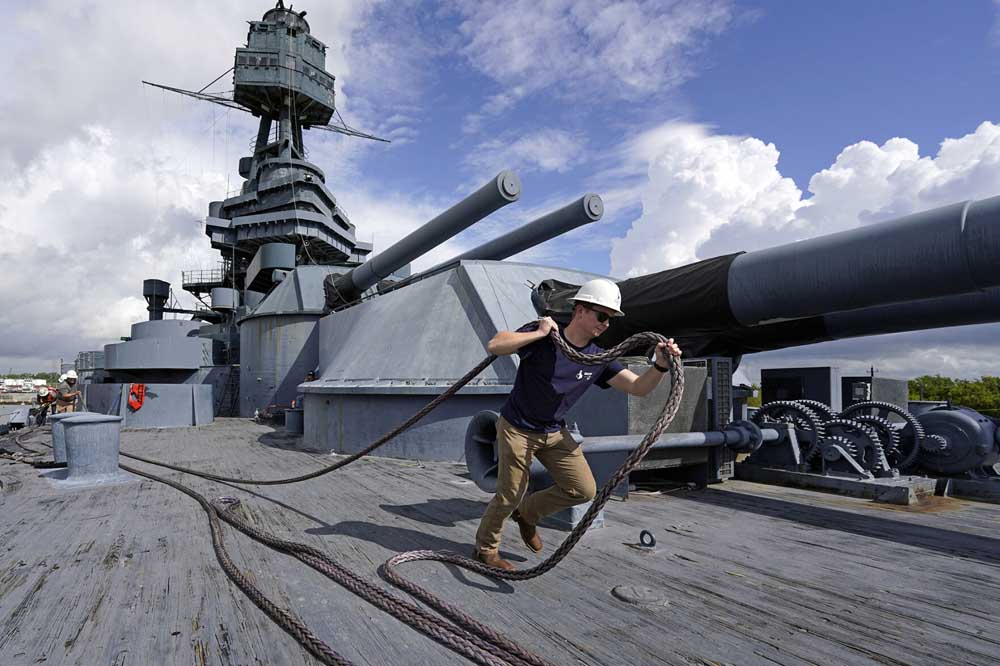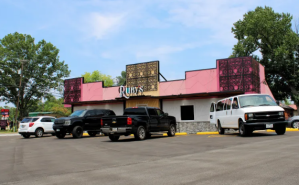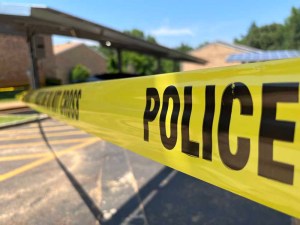Battleship blacksmith: Hallsville man gives new life to old steel from USS Texas
Published 5:35 am Monday, April 29, 2024

- Hunter Miertschin helps secure a rope on the USS Texas in August 2022 in La Porte. The vessel, which was commissioned in 1914 and served in both World War I and World War II, was towed down the Houston Ship Channel to a dry dock in Galveston, where it spent 18 months for repairs (AP File Photo)
Thomas Dean swings a hammer down on the top of a metal stamp, punching the letter “B” into the piece of steel locked in place on his workbench. A high-pitched pinging sound rings throughout his blacksmithing shop, housed in a metal barn across the yard from his home near Hallsville.
The “B” is the first letter in a two-word phrase embossed into the roughly 8-inch-by-9-inch piece of dark-colored steel that once sailed the seas: “BATTLESHIP TEXAS.”
Trending
Dean has marked about 300 other pieces of steel with those same words since January 2015. Other letters and numbers paying tribute to the same ship — such as “BB 35” — have been pressed into thousands of other pieces of scrap salvaged from the warship.
Dean is one of numerous blacksmiths and craftsmen from across the country turning rusty relics stripped from the Battleship Texas during a restoration effort into pieces of art. He makes plaques and paperweights out of steel removed from the ship, and the Battleship Texas Foundation gives those items to people who donate to the historic ship’s $75 million restoration effort.
“People want this steel,” Dean, 70, said as he stood in his shop on a recent morning, donning a faded denim jacket and jeans dusted with dirt — or rust. “And not just Texas people. They’re shipping this stuff, they’re mailing this stuff, all over the country.”
‘A significant piece of history’
More than 110 years ago, men made molten metal into sheets of steel, riveted them together and assembled a massive machine of war: the USS Texas, BB-35.
About 100 years later, some of that same metal — rusted after years of exposure to saltwater — was cut out of the ship’s belly and nearly scrapped. But some found its way to Hallsville, where it would be heated and treated for the last time. Once Dean turns it into paperweights and plaques, it probably will never be transformed into anything else.
Trending
“To me, it is a huge responsibility to do each piece to the best that I can so that it gives honor to the men that were involved in building and serving on her,” he said. “I hope I’m doing that.”
The USS Texas — a popular state historical destination — has been in various stages of restoration since 2013, with crews cutting out rusty metal, ripping up rotten deck wood and uninstalling other dilapidated components so they can be replaced, returning the ship to her early 20th century glory.
The Battleship Texas is the last surviving member of the “dreadnought” class of warships, the most formidable fighting vessels man had built up to that point in time, according to the Texas Parks and Wildlife Department. The 27,000-ton ship had a crew of more than 1,600 men and stretched 573 feet from bow to stern.
Her construction was a feat: The men of the Newport News Shipbuilding and Drydock Co. built her in one year, one month and one day, from April 17, 1911, to May 18, 1912. It was commissioned March 12, 1914.
The ship served the nation during World War I. Though it wasn’t in combat, it participated in maneuvers against German threats and escorted German ships to Scotland when the war was over, according to the Texas Parks and Wildlife Department.
In World War II, the battleship saw action in some of the most pivotal Allied campaigns: the invasions of North Africa, Normandy, Southern France, Iwo Jima and Okinawa.
“She’s a significant piece of history — Marine history, naval history, war history,” Dean said.
When the war was over, the ship was set to be used for bombing practice. But Texans saw that it was spared, raising funds to move it to its namesake state to become the first permanent memorial battleship, according to the Texas Parks and Wildlife Department, which oversaw the ship as a historical site. For decades, the ship was on display at the San Jacinto Battleground in La Porte, where people could climb aboard for a tour.
The ship remained in the water, where problems with leaking sprang up through the years, sometimes forcing officials to cancel tours. In 2013, the state spent $17.5 million repairing the ship’s hull.
Rusty metal from its interior was removed at that time, and some Houston-area blacksmiths asked if they could get their hands on it. When one of the blacksmiths offered the metal to fellow blacksmiths during a conference — on the condition that they donate the goods they create to the Battleship Texas Foundation, which is dedicated to the ship’s preservation — Dean signed up.
One day in May 2014, after he retired from his career with Eastman Chemical Co., his phone rang.
The making of a memento
The parameters for Dean were almost too freeing: “Do whatever you want to with it.”
When Dean was offered a piece of metal from the ship, Dean and his wife took off to pick it up.
“And then it laid in here in this shop, and me scratching my head, ‘What am I going to do with this thing?’” he said.
The piece he got came from the ship’s bulkheads, which stored oil used for fuel. It had two rows of rivets that intersected at a joint where pieces of metal came together. He got an idea.
He cut part of the riveted joint out and stamped information about the ship onto an adjoining flat piece. He also cut a small piece of metal into the shape of a star and another into the shape of Texas and welded them onto it, making a commemorative plaque. He packed it up, tucked his contact information inside the box and shipped it to the Battleship Texas Foundation.
The foundation presented that plaque to the shipyard that built the battleship as a way to help the company honor its history. Soon after, the former foundation superintendent asked Dean to make more.
He wouldn’t make them identical to the first. “That’s a one-of-a-kind. I want it to stay that way,” he said. But he agreed to make a different kind.
He got his first order of plaques in January 2015. Most measure roughly 8 inches wide by 9 or 10 inches tall. The thickness varies, depending on the condition of the metal — some is “immaculate,” Dean said, while some has seen more decay — and all have six rivets in them.
Dean cuts the plaques from the metal he has on hand. He heats it in a forge to remove caked-on oil. Later, he places the piece on his workbench, where vice-grips — each locked onto a different metal letter stamp — are lined up in order. He secures the metal to table, and one by one, he uses a hammer to stamp the letters into the steel, spelling “Battleship Texas,” along with the dates the ship was commissioned and decommissioned.
He flips the piece over and stamps his initials on the back. He welds a pre-cut star and Texas-shaped piece onto the front, rubs a brass brush over them to give them a shiny look and then applies clear-coat to plaque. And with that, it’s complete.
That’s one of three items Dean makes for the foundation. Those plaques, which he calls the “large plaques,” are given to people who donate $1,000 to the foundation for the restoration. Donations can be made on the foundation’s website, but only the items that are available at the time will be shown there, Dean said.
The same Texas-shaped pieces of metal he welds onto the plaques — measuring roughly 3 inches by 3 inches — are paperweights that donors can get for $150 each. They’re stamped with “BB 35” and the date the ship was commissioned. While he stamps them, a local company, J.D.L. Enterprises, cuts the metal for him.
He also makes what he calls a “small plaque,” which has four rivets and usually is around 5 inches by 6 inches. It’s stamped only with “BB 35.” A $500 donation is required.
So far, he said he’s made about 300 large plaques, close to 45 small plaques and around 5,300 paperweights. He estimates those items have raised approximately $1 million for the ship’s restoration efforts.
While the battleship foundation pays him for his work, he hasn’t made nearly that much money.
“I don’t want to take away from the battleship,” he said.
Tons of work ahead — literally
Dean was 18 years old when he started working as a welder at a small engine repair shop in Gothwaite. He found a love for mending metal, but he didn’t pursue blacksmithing himself until 1999, when he spent a day learning from the blacksmith at the Silver Dollar City theme park in Branson, Missouri. Dean’s occupation as a welder — both for a pressure vessel shop in Longview and a 29-year career at Eastman as a welder and pipe fabricator — gave him a hand up with handling metal.
These days, he teaches blacksmithing classes for youth at his shop, which is nestled beneath the dense forest surrounding his home. A wooden wagon wheel hangs over the front door of the barn, and inside, the tools of the trade — from hand-made hammers to a traditional forge — fill the floor.
“I do my blacksmithing because I love that history. I love the old ways,” he said.
Dean keeps history alive in other places, too. He makes an annual blacksmithing demonstration at the Dalton Days festival in downtown Longview, an event telling the story of the day the infamous Wild West gang robbed a bank here.
Dean, an official vendor for the battleship foundation, is one of countless craftsmen across America who’ve taken material from the ship and transformed it into everything from furniture to knives to chess pieces. He said he’s a member of the Battleship Texas Artisans group, though his work for the foundation isn’t tied to the association of artists.
Today, the battleship — now operated by the foundation — continues to undergo restoration work. It was moved to Galveston in 2022 for 18 months’ worth of repairs in dry dock, and in March, it was refloated for the first time.
Its permanent home, where it will reopen to visitors in 2025 or 2026, will be in Galveston, according to the foundation. The Texas Legislature has allocated $60 million for the project since 2019.
“She’s in the best shape that she has been in since World War II — actually, since she was built,” Dean said.
At times, blacksmithing the battleship metal has made him emotional, Dean said. His father was in World War II, just like the men who built and served on the ship.
“I’m working on stuff that men touched 100 years ago, 100-plus years ago,” he said. “The ship fought two battles to preserve our freedom, and it was just like, ‘Man.’ So, not everybody gets to do that.”
The sound of Dean’s hammer striking metal letters into plaques will ring throughout his shop for the foreseeable future. He’s been given about 14 tons of metal from the ship and has used about 4.
So, how long will he keep turning the Battleship Texas’ steel into souvenirs? He said continuing to work keeps him in good shape. He knows about men who kept blacksmithing until they were in their 90s.
“Short answer,” he said, “as long as the Lord gives me the ability to swing a hammer or the battleship runs out of steel.”







